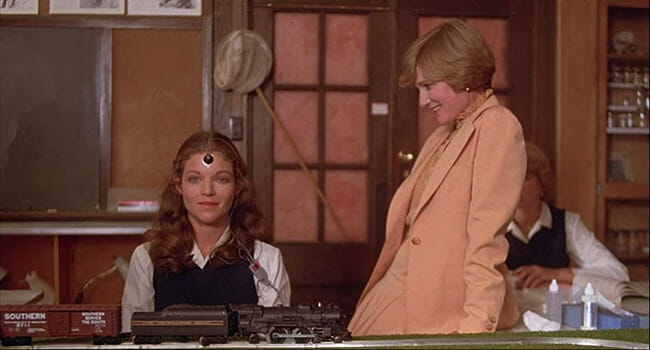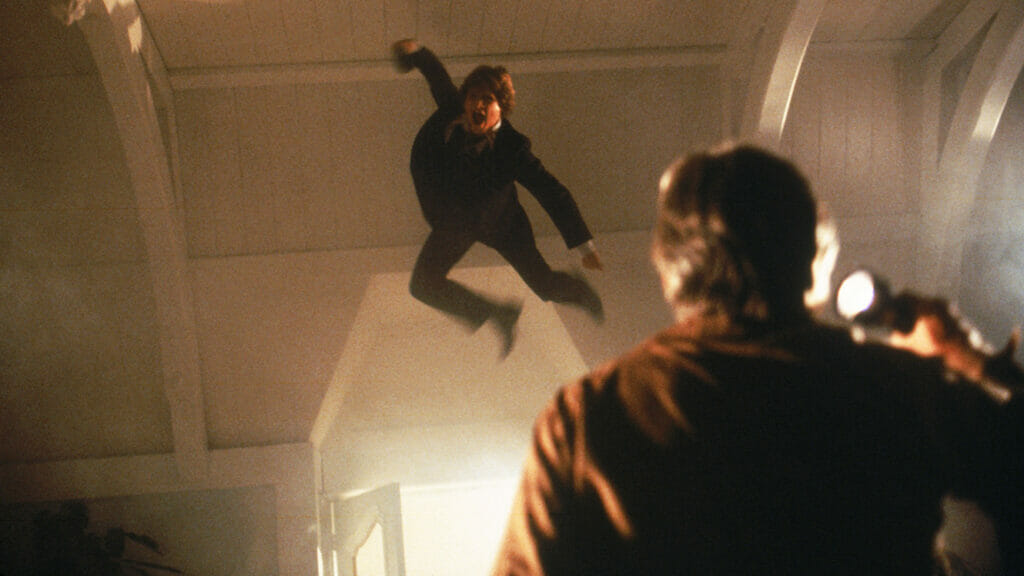Brian De Palma’s follow-up to Carrie, The Fury remains a messy but fascinating entry in his diverse filmography.
Having finally achieved his long-overdue commercial breakthrough with Carrie, fans of idiosyncratic filmmaker Brian De Palma were curious as to what he might come up with next. However, few were expecting him to do another supernatural thriller that utilized many of the same elements that he deployed in the previous film—troubled teens beset by ruthless and unimaginably cruel villains until they finally snap in hellacious fashion, telekinetic powers, the presence of Amy Irving. But that’s exactly what he did with his 1978 film The Fury, and while the result may not be anywhere close to the classic that Carrie is, it remains a stylish and entertaining work that contains some of the most spectacular set pieces in a career that is not exactly lacking in such things.
The film opens in Israel as ex-CIA agent Peter Sandza (Kirk Douglas) is relaxing on the beach with his son Robin (Andrew Stevens), a young man with psychic abilities. Peter explains to former agency colleague Ben Childress (John Cassavetes) that he is leaving his old life behind and returning to the U.S. with Robin. As the leader of a covert program that tracks down psychic children in order to harness and weaponize their powers, Childress is not thrilled by this news and stages a faux Arab terrorist attack that will allow him to kill Peter and bring Robin in under the guise of protecting him from the forces that allegedly killed his father. Peter survives, maiming Childress’s arm in the process, but is unable to prevent him for getting away with Robin, who thinks that he is dead.
Months later, the story picks up in Chicago as high school student Gillian Bellaver (Irving) discovers that she has psychic powers of her own that will bring physical and/or emotional harm to anyone who touches or upsets her, especially her classmates (including Daryl Hannah and Laura Innes in early roles). In the hopes of learning to control these powers, she enrolls at the Paragon Institute, a live-in facility focused on psychic powers in children run by Dr. Jim McKeever (Charles Durning). It turns out that McKeever is working in conjunction with PSI, the aforementioned covert agency led by Childress. Robin used to go there until he was shipped off to PSI headquarters, where he has essentially been brainwashed by Childress and colleague Susan (Fiona Lewis)—who has also been manipulating Robin sexually—in order to develop his powers to staggering levels.

During her stay, Gillian’s powers develop as well, and she begins to have visions of Robin being abused by members of the Institute, which lead to her contacting him telepathically. Fearing that she is getting too powerful, Childress makes arrangements to send her to PSI as well, but Hester (Carrie Snodgress), a Paragon nurse, informs Peter, her lover, about the new girl and her powers and he arranges an escape for Gillian so that she can use her psychic connection to lead him to his son. Unfortunately, Robin has grown increasingly unstable with the growth of his powers and has begun acting out in more overtly violent ways. Upon encountering a group of Arabs, whom he associates with those who supposedly killed his father, at the late, great Old Chicago indoor amusement park, he deploys his powers against them in spectacularly grisly fashion.
If this project, with its obvious echoes of Carrie, seems like an odd choice for De Palma to have chosen to follow, it appears that he looked upon it largely as a means to a particular end. At the time, he was keenly interested in doing an adaptation of Alfred Bester’s 1953 novel The Demolished Man, a sci-fi-thriller involving a murder in a futuristic telepathic society, and had even co-written a screenplay for it with author John Farris. As a way of working out the elaborate visual storytelling and special effects required to bring that project to life, De Palma elected to first make a film of Farris’s 1976 novel The Fury with the author doing the screenplay, changing a considerable amount of the narrative in the process.
Even by De Palma’s occasionally lax attitude towards narrative coherence, The Fury is pretty perplexing, and even supporters of the film tend to be at a loss when it comes to explaining what the hell is going on at any given point. Oh sure, there is always a lot of stuff happening—chases, explosions, psychic visions and the like—but none of it really makes sense, coming across at times like an especially loopy episode of The X Files. To be fair, a film like this is always going to be preposterous to some degree, but The Fury starts at peak lunacy and only gets more bewildering from there.
Another problem with the story is that the characters are not particularly interesting and therefore difficult to care about. In Carrie, for example, viewers found themselves instantly sympathizing with Carrie White (aided in no small part by the wonderful Sissy Spacek performance) so that when she was finally pushed too far and let her powers loose at full blast at last, they found themselves mourning the loss of the sweet sad girl they had gotten to know even as they cheered her as she got her revenge. Here, the characters are ciphers who exist solely to be pushed around by the machinations of the plot, a sensation that is not helped by performances ranging from gleeful scenery-chewing excess (Douglas and Cassavetes) to borderline somnambulistic (Stevens and Irving).

And yet, while I would never try to make the case that The Fury is a great movie by conventional standards, it is nevertheless a pretty great Brian De Palma movie, because he correctly sees the crackpot narrative as little more than a laundry line to connect elaborately designed and executed visual set pieces. Here, he’s conjured up some true stunners, ranging from a car chase that extends from Chicago’s Lower Wacker Drive to a fog-bound Navy Pier, to the jaw-dropping slo-mo escape of Gillian from the clutches of Paragon, to the chaos that unfolds at Old Chicago under Robin’s watchful gaze, all elevated to new heights by the stunning cinematography by Richard H. Kline and driven further by one of John Williams’ greatest, if most underrated, scores.
Then there is the finale, in which (spoiler alert) Gillian confronts Childress and things do not end well for one of them, to say the least. Viewers who had seen Carrie and its famous gut-punch finale may have wondered how De Palma might top himself this time around (especially considering the fairly drab note the book ended on) but it’s doubtful that they were prepared for what they got, an insanely overblown example of Grand Guignol-style grisliness. That would have been enough, but De Palma gleefully pushes things even further by staging the action in what appears to be a deliberate spoof of the finale of Michelangelo Antonioni’s Zabriskie Point. Put it this way—even if everything up to this point in The Fury had been absolute shit, it would still be worth watching for this moment alone.
When it opened in the spring of 1978, The Fury was a moderate box-office success but neither outgrossed Carrie, or did enough business to get The Demolished Man made (it remains un produced to this day). As has been the case with most De Palma films, the reviews were all over the place—some critics admired the style and action while admitting that it made no sense, others decried it for being an incoherent bloodbath. Pauline Kael (then a De Palma supporter) wildly celebrated it in a review that may have given more genteel New Yorker subscribers pause if they took her advice and went to see it without knowing what they were in for. As for De Palma, he next made the low-budget oddity Home Movies (1979), before moving to straight suspense with two of his greatest films, Dressed to Kill (1980) and Blow Out (1981).
The Fury is far from perfect—“bonkers” is probably a more accurate description—and those who have never had the pleasure of watching a Brian De Palma film before would be wise not to make it their first dive into his often outré filmography. However, as an example of the kind of memorable cinematic magic that he could conjure even within the confines of a somewhat dubious screenplay, it remains a wicked delight that takes such pleasure in its self-aware outrages that you can practically hear De Palma cackling during every scene.